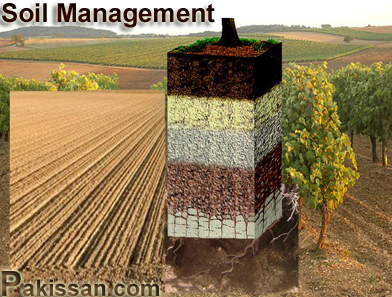Soil management
By Manitoba Eco Network
 Besides
storing more carbon and making more efficient use of
nitrogen, good soil management will provide economic
benefits through increased productivity, more efficient use
of nutrients, and improved air and water quality.
Besides
storing more carbon and making more efficient use of
nitrogen, good soil management will provide economic
benefits through increased productivity, more efficient use
of nutrients, and improved air and water quality.
Agricultural soils act as
efficient repositories for carbon, but under certain
conditions soils also release carbon dioxide back into the
atmosphere.
Plants fix atmospheric
carbon into foliage and roots, which eventually becomes soil
organic matter.
Soil organic matter is
fundamental to healthy soil.
While much of the stored
carbon is released back into the atmosphere when plants
decay, some of it remains trapped in the soil as organic
matter.
Through denitrification and
other processes soils also release excess nitrogen into the
atmosphere as nitrous oxide and nitrogen gas.The following
farming practices can reduce the amount of greenhouse gas
emissions from soils.
"Low till" (Conservation tillage)
In conservation tillage, crops are directly planted into the
previous year’s stubble, with minimum or no tillage. This
practice not only reduces fossil fuel consumption, but also
increases soil organic matter (compared to conventional
tillage*) that otherwise would be emitted as carbon dioxide.
Conservation tillage, along with reduced use of summerfallow,
can store from 0.3 to 0.5 tonnes of carbon per hectare per
year in the soil, depending on weather and moisture
conditions.
As well, research from the University of Saskatchewan has
shown there’s more available organic nitrogen in long-term
zero tillage fields than in fields tilled using conventional
methods.
Choosing to seed with narrow, low disturbance openers
(knives or discs) has the further advantage of minimal
seedbed disturbance. Crops seeded with low disturbance disc
and knife openers have shown improved production and fewer
weeds over crops seeded with higher disturbance openers,
such as spoons or sweeps.
Additional benefits of conservation tillage include enhanced
water infiltration, moisture conservation, reduced labour
requirements, and less runoff and soil erosion due to wind
and water.
Crop rotations
The best crop rotations should not only effectively manage
nutrients and reduce pest problems, but also improve soil
quality. While the environmental benefits of certain crop
rotations are clear, market constraints may limit which
crops are included. Some suggestions:
The addition of legume crops in crop rotations will fix
nitrogen. Perennial legumes, such as alfalfa, increase soil
organic matter, while the residues contain nitrogen, which
can easily be broken down to be used by subsequent crops.
Crops with high nitrogen requirements, such as corn or
cereals, used as a follow-up to legumes will capitalize on
the fixed nitrogen in the soil.
Planting a winter cereal or another cover crop after harvest
(if timing permits) will help remove surplus nitrogen. Cover
crops also store nutrients for the crops that follow them,
as well as reduce weeds, host beneficial insects, and
improve soil quality.
Forage production is a further way to reduce emissions.
Increasing forage production not only increases soil organic
carbon, but it also uses surplus soil nutrients, reducing
the risk of nitrogen losses, including denitrification.
Crop mixtures, such as alfalfa-bromegrass, use soil nitrogen
more efficiently and reduce the potential for nitrogen
losses to the environment.
Marginal land
Marginal lands require the same inputs as productive land,
but produce lower yields and profit. By planting these
marginal or fragile lands to perennial cover, farmers can
improve profit margins, create a carbon sink and provide
natural habitat.
The best solution for flood-prone areas or lands with excess
moisture may be restoring them back to wetlands. Wetlands
can remove carbon dioxide from the atmosphere, reduce
downstream flooding, help to clean water and provide
wildlife habitat.
Stubble burning
On average, more than 90 percent of all carbon in crop
residues is lost (mostly as carbon dioxide) when it is
burned. Alternate uses for cereal straw include chopping and
spreading back onto the fields, baling, grazing, and using
for bio-energy feedstock and bio-fibre.
Soil drainage
Since saturated soils during the growing season are more
prone to denitrification and producing nitrous oxide
emissions, improving drainage encourages efficient crop
growth and uptake of nitrogen fertilizer.
Drainage improvements may include enhanced surface drainage,
installation of tile drains, or the use of trees, shrubs and
other perennial crops to remove excess water. In some cases,
it may be more appropriate to store water and refrain from
annual crop production and fertilizer applications.
Soil cover
Crop residues left on the surface help prevent soil erosion.
Manitoba Agriculture recommends that 60 percent of the soil
surface should be covered with crop residue in the fall to
prevent erosion.
Summerfallow
Summerfallow is already a dying practice in Manitoba. But it
is worth noting that besides leaving fields susceptible to
wind and soil erosion, soils that were frequently
summerfallowed usually had reduced soil organic matter
compared to continuously cropped soils.
This practice reduces the
rate of organic matter breakdown compared to conventional
tillage methods. Tillage buries stubble and aerates the
soil. This increases the rate of soil organic matter
breakdown. Conservation tillage doesn’t increase soil
organic matter compared to forest or prairie.
October, 2013
Source:
Climate Change
Connection